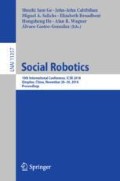Abstract
In this article we present the detection of fatigue level of a vehicle driver and according to this level the autonomous driving assistance is implemented, the detection of fatigue level is based on facial recognition using deep learning (Deep Learning) developed in the Matlab software, applying neural networks previously trained and designed, this detection sends us a metric that comprises four levels, according to the metric the position and velocity control of a simulated Car-Like vehicle in the Unity3D software is performed which presents a user friendly environment with the use of haptic devices, the development of the control algorithm is based on path correction which calculates the shortest distance to reenter the desired path.
Access this chapter
Tax calculation will be finalised at checkout
Purchases are for personal use only
References
Wei, W., Hanbo, F.: Traffic accident automatic detection and remote alarm device. In: 2011 International Conference on Electric Information and Control Engineering, Wuhan, pp. 910–913 (2011)
Lia, C.: Intelligent traffic accident detection system based on mobile edge computing. In: 2017 3rd IEEE International Conference on Computer and Communications, China, pp. 2110–2115 (2017)
World Health Organization: Global status report on road safety 2015. World Health Organization (2015)
Agencia Nacional de Transito del Ecuador. Estadísticas de Siniestros. https://ant.gob.ec
Agencia Nacional de Transito del Ecuador. Estadísticas de mortalidad. https://ant.gob.ec
Traffic Incident Management: Federal Highway Administration. http://ops.fhwa.dot.gov/aboutus/one_pagers/tim.htm. Accessed 15 Oct 2013
The Royal Society for the Prevention of Accidents: Driver fatigue and road accidents: a literature review and position paper, Birmingham, U.K. (2001)
Eriksson, M., Papanikotopoulos, N.P.: Eye-tracking for detection of driver fatigue. In: 1997 IEEE Conference on Intelligent Transportation System. LTSC 1997. IEEE (1997)
Shu-ming, S., et al.: Driver mouth monitoring method based on machine vision. J. Jilin Univ. Technol. (Nat. Sci. Ed.) 2, 014 (2004)
Tomlin, R., Villa, V.: Attention in Cognitive Science and Second Language Acquisition. Stud. Sec. Lang. Acquis. 16, 183–203 (2008)
Shia, V., et al.: Semiautonomus vehicular control using driver modeling. IEEE Trans. Intell. Transp. Syst. 15(6), 2696–2709 (2014)
Tomas-Gabarron, J.B., Lopez, E., García, J.: Vehicular trajectory optimization for cooperative collision avoidance at high speeds. IEEE Trans. Intell. Transp. Syst. 14(4), 1930–1941 (2013)
Lin, C.-T., et al.: EEG-based drowsiness estimation for safety driving using independent component analysis. IEEE Trans. Circ. Syst. I: Regul. Pap. 52(12), 2726–2738 (2005)
Swarnkar, V., Abeyratne, U., Hukins, C.: Objective measure of sleepiness and sleep latency via bispectrum analysis of EEG. Med. Biol. Eng. Comput. 48(12), 1203–1213 (2010)
Roy, R.N., Charbonnier, S., Bonnet, S.: Eye blink characterization from frontal EEG electrodes using source separation and pattern recognition algorithms. Biomed. Signal Process. Control 14, 256–264 (2014)
Tan, X., Triggs, B.: Enhanced local texture feature sets for face recognition under difficult lighting conditions. IEEE Trans. Image Process. 19, 1635–1650 (2010)
Zeng, J.: Deep learning based forensic face verification in videos. In: IEEE Conference on Computer Vision and Pattern Recognition, pp. 77–80 (2017)
Parkhi, O.M., Vedaldi, A., Zisserman, A.: Deep face recognition. In: Proceedings of the British Machine Vision Conference, pp. 41.1–41.12 (2015)
Taigman, Y., Yang, M., Ranzato, M., Wolf, L.: DeepFace: closing the gap to human-level performance in face verification. In: IEEE Conference on Computer Vision and Pattern Recognition, pp. 1701–1708 (2014)
Schroff, F., Kalenichenko, D., Philbin, J.: FaceNet: a unified embedding for face recognition and clustering. In: IEEE Conference on Computer Vision and Pattern Recognition, pp. 815–823 (2015)
Krizhevsky, A., Sutskever, I., Hinton, G.: ImageNet classification with deep convolutional neural networks. In: NIPs Proceedings of Neural Information Processing Systems Conference (2012)
Acknowledgements
The authors would like to thanks to the Corporación Ecuatoriana para el Desarrollo de la Investigación y Academia –CEDIA for the financing given to research, development, and innovation, through the CEPRA projects, especially the project CEPRA-XI-2017- 06; Control Coordinado Multi-operador aplicado a un robot Manipulador Aéreo; also to Universidad de las Fuerzas Armadas ESPE, Universidad Técnica de Ambato, Escuela Superior Politécnica de Chimborazo, and Universidad Nacional de Chimborazo, and Grupo de Investigación en Automatización, Robótica y Sistemas Inteligentes, GI-ARSI, for the support to develop this work.
Author information
Authors and Affiliations
Corresponding authors
Editor information
Editors and Affiliations
Rights and permissions
Copyright information
© 2018 Springer Nature Switzerland AG
About this paper
Cite this paper
Mayorga, O.A., Andaluz, V.H. (2018). Autonomous Control Through the Level of Fatigue Applied to the Control of Autonomous Vehicles. In: Ge, S., et al. Social Robotics. ICSR 2018. Lecture Notes in Computer Science(), vol 11357. Springer, Cham. https://doi.org/10.1007/978-3-030-05204-1_12
Download citation
DOI: https://doi.org/10.1007/978-3-030-05204-1_12
Published:
Publisher Name: Springer, Cham
Print ISBN: 978-3-030-05203-4
Online ISBN: 978-3-030-05204-1
eBook Packages: Computer ScienceComputer Science (R0)

